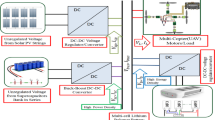Abstract
The need for the unmanned ground combat vehicle (UGCV), which is used for the surveillance, reconnaissance and targeting during extremely dangerous condition on the battlefield, has steadily increased, and the transition from manned ground combat vehicles to unmanned ground combat vehicles is expected to reduce the loss of lives during battle. The UGCV needs many types of capabilities to achieve satisfactory performance. This paper focuses on the modeling and control of the power system of the UGCV, and proposes the fuel cell hybrid system (FCHS) for the power system of the UGCV. The fuel cell hybrid system has many advantages in stealth drive and the system efficiency. In addition, the FCHS is much quieter than the engine generator and generates much less heat. The benefits of the FCHS are advantageous for use in Army operations, which require ‘silent watch’ capability and the ability to operate without showing up on an enemy’s radar screen. The FCHS has a fuel cell and uses an energy storage system (ESS) as a power source. The ESS (e.g., batteries or ultracapacitors) helps the fuel cell supply power to the electric drive system and also recovers energy during deceleration. The ESS makes it possible to improve the efficiency and dynamic characteristic of the power system. In this paper, the FCHS is composed of different combinations of component models. The component sizes are chosen to satisfy performance requirements. In order to determine the power distribution between the fuel cell and the ESS, a power management strategy based on the required power and the SOC (state of charge) of the ESS is proposed. Batteries and ultracapacitor, components of the ESS, have different characteristics. Accordingly, varying the combination of ESS components can change the performance of the power system. The performance of the FCHS with respect to different combinations of ESS is analyzed using simulated results.
Similar content being viewed by others
References
Baisden, A. C. and Emadi, A. (2004). Advisor-based model of a battery and an ultra-capacitor energy source for hybrid electric vehicles. IEEE Trans. Vehicular Technology 53, 1, 199–205.
Barker, P. P. (2002). Ultracapacitors for use in power quality and distributed resource applications. IEEE Power Engineering Society Meeting 2002, 1, 316–320.
Ehsani, M., Gao, Y. and Butler, K. L. (1999). Application of electrically peaking hybrid propulsion system to a full-size passenger car with simulated design verification. IEEE 0018-9545-99.
Gao, Y. and Ehsani, M. (2001). Systematic design of fuel cell powered hybrid vehicle drive train. SAE Paper No. 2001-01-25.
Hauer, K. H. and Moore, R. M. (2003a). Fuel cell vehicle simulation — Part 2: Methodology and structure of a new fuel cell simulation tool. Fuel Cells (WILEY-VCH Verlag GmbH & Co. KGaA, Weinheim) 3, 3, 95–104.
Hauer, K. H. and Moore, R. M. (2003b). Fuel cell vehicle simulation — Part 3: Modeling of individual components and integration into the overall vehicle model. Fuel Cells (WILEY-VCH Verlag GmbH & Co. KGaA, Weinheim) 3, 3, 105–121.
Jeanneret, B. and Markel, T. (2004). Adaptive energy management strategy for fuel cell hybrid vehicles. SAE Paper No. 2004-01-1298.
Park, C., Oh, D., Kim, D. and Kim, H. (2004). Development of fuel cell hybrid electric vehicle performance simulator. Int. J. Automotive Technology 5, 4, 287–295.
Natinal Renewable Energy Laboratory. ADVISOR Documentation. Golden, Co. Available on http://www.ctts.nrel.gov/analysis.
Schupbach, R. M. and Balda, J. C. (2003). Design methodology of a combined battery-Ultracapacitor energy storage unit for vehicle power management. IEEE Power Electronics Specialist Conf., 1, 88–93.
Zolot, M. (2003). Dual-source energy storage-control and performance advantages in advanced vehicles. EVS-20 Proc.
Author information
Authors and Affiliations
Corresponding author
Rights and permissions
About this article
Cite this article
An, S.J., Lee, K.I. & Kim, T.J. Performance analysis according to the combination of energy storage system for fuel cell hybrid vehicle. Int.J Automot. Technol. 9, 111–118 (2008). https://doi.org/10.1007/s12239-008-0014-9
Received:
Revised:
Published:
Issue Date:
DOI: https://doi.org/10.1007/s12239-008-0014-9




